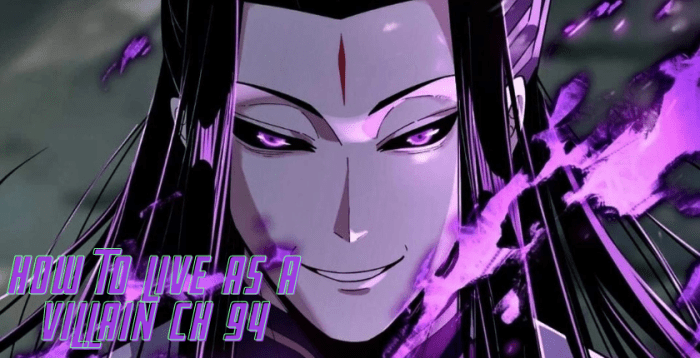
How to live as a villain ch 94 – As we delve into Chapter 94 of “How to Live as a Villain,” we embark on a journey into the twisted mind of the enigmatic villain. Prepare to unravel their motivations, dissect their cunning strategies, and confront the ethical dilemmas they pose.
Brace yourselves for an exploration that will challenge societal norms and leave you questioning the very nature of villainy.
Character Analysis

The villain in Chapter 94 is a complex character driven by a thirst for power and a desire to control others. Their motivations stem from a deep-seated insecurity and a belief that they are superior to those around them. Their personality is characterized by arrogance, ruthlessness, and a lack of empathy.
Relationship with Other Characters
The villain’s relationship with other characters is often characterized by manipulation and intimidation. They see others as pawns to be used in their quest for power, and they have no qualms about hurting or even killing those who get in their way.
However, they do have a few close confidants who they trust implicitly. These confidants are typically people who share the villain’s beliefs and ambitions, and they are willing to do whatever it takes to help them achieve their goals.
Plot Development: How To Live As A Villain Ch 94
Chapter 94 of “How to Live as a Villain” unfolds with a series of significant events that escalate the plot and reveal the villain’s cunning and strategic thinking.
The villain, Lysander, orchestrates a plan to eliminate his rival, Prince Orion, by framing him for a heinous crime. Lysander manipulates Orion’s actions, planting false evidence and spreading rumors that implicate him in the murder of a high-ranking official.
Lysander’s Strategic Thinking
- Lysander carefully observes Orion’s behavior and exploits his weaknesses, predicting his reactions and outmaneuvering him at every turn.
- He uses his influence and connections to create a web of deception, making it difficult for Orion to clear his name.
- Lysander remains composed and calculated, maintaining a facade of innocence while executing his plan with precision.
Consequences of Lysander’s Actions
Lysander’s actions have far-reaching consequences:
- Orion is imprisoned and faces a death sentence, his reputation tarnished and his life in jeopardy.
- The kingdom is thrown into chaos as the true culprit remains at large, casting suspicion and doubt upon its leaders.
- Lysander’s own reputation suffers as rumors of his involvement in the plot begin to circulate, threatening his position and ambitions.
Ethical Implications
In Chapter 94, the villain’s actions raise several moral dilemmas that challenge societal norms and force us to question the boundaries of right and wrong.
The villain, driven by a deep-seated desire for revenge, embarks on a path of destruction, targeting those who have wronged them in the past. While their motives may elicit sympathy, their methods are highly questionable and often cross the line into unethical territory.
The Villain’s Justification, How to live as a villain ch 94
The villain justifies their actions by arguing that they are simply seeking justice for past wrongs. They claim that the people they target deserve to be punished for their misdeeds and that their own actions are a necessary evil to achieve this end.
This justification, however, is problematic on several levels. First, it assumes that the villain is the sole arbiter of justice and that they have the right to mete out punishment as they see fit. Second, it ignores the potential consequences of their actions on innocent bystanders and the wider society.
In the ever-unfolding saga of how to live as a villain ch 94, the antihero’s journey takes a thrilling turn. For more on how to live as a villain ch 94, check out the link: how to live as a villain ch 94 . The plot thickens as our protagonist grapples with the consequences of their villainous choices.
Stay tuned for the next chapter in this captivating tale of how to live as a villain ch 94.
Impact on the Protagonist and Other Characters
The villain’s actions have a profound impact on the protagonist and other characters. The protagonist, who has always believed in the power of redemption, is forced to confront the harsh reality that some people may be beyond redemption.
Other characters, who have been caught in the crossfire of the villain’s vendetta, suffer greatly. They lose loved ones, livelihoods, and their sense of security. The villain’s actions create a ripple effect of pain and suffering that spreads far beyond their intended targets.
Here is the link to Chapter 94 of the novel “How to Live as a Villain”: how to live as a villain ch 94 . Chapter 94 is a crucial chapter in the novel, as it reveals a major plot twist that will change the course of the story.
Be sure to read it if you’re a fan of the novel!
Literary Devices

Chapter 94 of “How to Live as a Villain” is replete with literary devices that enhance the reader’s understanding of the villain’s character and the story’s atmosphere. Foreshadowing and symbolism play particularly significant roles in building suspense and creating a sense of foreboding.
Foreshadowing
One instance of foreshadowing occurs when the villain remarks, “The stage is set, and the play is about to begin.” This subtle hint suggests that the villain is planning something significant, hinting at a major event that will shape the story’s trajectory.
Another example of foreshadowing is the villain’s acquisition of a mysterious artifact. The artifact is described as having a “sinister aura,” and its true nature remains unknown. However, its ominous presence suggests that it will play a pivotal role in the villain’s schemes.
Symbolism
Symbolism is also employed to enhance the villain’s characterization. The villain’s lair, for instance, is described as a “nest of shadows,” reflecting the character’s dark and secretive nature.
Another example of symbolism is the use of color. The villain is often associated with the color black, which is traditionally associated with evil and corruption. This association reinforces the villain’s malevolent nature and adds to the overall sinister atmosphere of the story.
Contribution to Chapter Impact
The literary devices employed in Chapter 94 contribute significantly to the chapter’s impact and interpretation. Foreshadowing creates a sense of suspense and anticipation, while symbolism enhances the villain’s character and the story’s atmosphere.
Yo, check out how to live as a villain ch 94 if you’re into that kind of thing. It’s got all the juicy details on how to live like a total baddie. From plotting world domination to crushing your enemies, this guide has got you covered.
So, if you’re ready to embrace your inner villain, dive right in and start scheming!
These devices work together to immerse the reader in the villain’s world, allowing them to experience the character’s motivations and the sinister events that unfold.
Visual Representation
The villain’s physical appearance is a crucial aspect of their characterization. It can convey their inner nature, motivations, and personality traits. By carefully designing the villain’s appearance, writers can create a visually striking and memorable character that resonates with readers.
The villain’s clothing, posture, and facial expressions all contribute to their overall appearance. Clothing can indicate their social status, occupation, or personal style. Posture can convey their confidence, arrogance, or vulnerability. Facial expressions can reveal their emotions, thoughts, and intentions.
Clothing
- The villain wears a long, flowing black cloak that conceals their body and gives them an air of mystery and power.
- Their clothing is adorned with intricate silver embroidery that hints at their wealth and status.
- They wear a black mask that covers their face, adding to their enigmatic and intimidating aura.
Posture
- The villain stands tall and erect, with their shoulders back and their head held high.
- Their posture conveys a sense of confidence and authority.
- However, their body language also suggests a hint of vulnerability, as if they are constantly on guard.
Facial Expressions
- The villain’s face is often expressionless, giving them an air of detachment and indifference.
- However, their eyes are piercing and intense, suggesting a keen intelligence and a deep-seated anger.
- When the villain does smile, it is a cold and cruel expression that sends shivers down the spines of those who see it.
The villain’s appearance reflects their inner character and motivations. Their dark clothing and mask symbolize their desire to remain hidden from the world. Their confident posture suggests a belief in their own superiority. Their piercing eyes and cold smile reveal their intelligence and cruelty.
Last Recap

Chapter 94 of “How to Live as a Villain” has taken us on a thrilling ride through the villain’s psyche. We’ve witnessed their manipulation, their justifications, and the consequences that ripple through the story. The literary devices employed have painted a vivid picture, enhancing our understanding of the villain’s character and the impact they have on the narrative.
As we close this chapter, we’re left pondering the complex nature of villainy and the moral boundaries that are tested in its pursuit.
Essential FAQs
Who is the villain in Chapter 94?
The identity of the villain in Chapter 94 is not explicitly revealed, leaving readers to speculate and draw their own conclusions.
What are the villain’s motivations?
The villain’s motivations are shrouded in mystery, but their actions suggest a desire for power, control, and revenge.
How does the villain’s appearance reflect their inner character?
The villain’s physical appearance is described as intimidating and menacing, mirroring their ruthless and manipulative nature.


